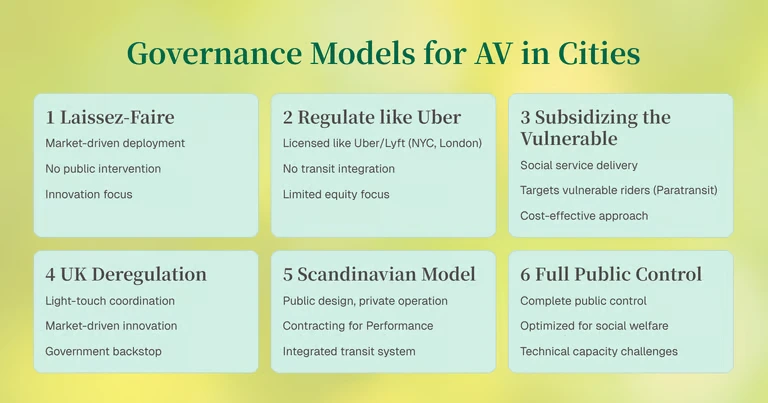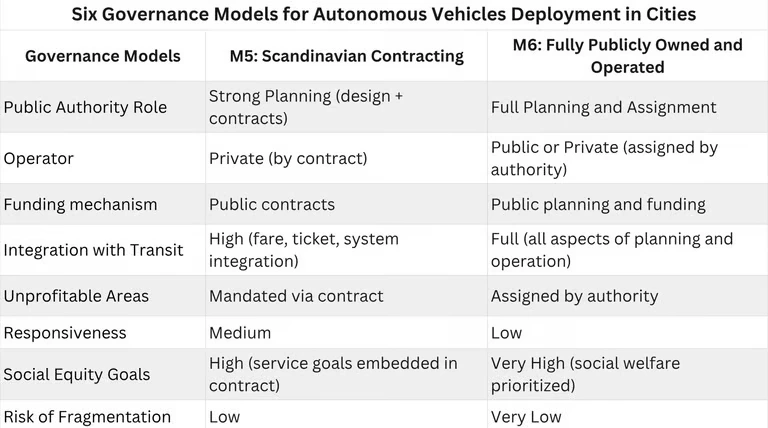

AVs are not the problem. Governing them is.
We’ve studied global experiments in London, Boston, Singapore, Stockholm, and beyond—and developed six governance models for AV deployment in cities:
🔹 1. Laissez-Faire
No public intervention. Pure market competition. AV providers cherry-pick the most profitable areas. Innovation thrives—but often with little regard for public interest. Can an open AV market self-correct? Unlikely.
🔹 2. Regulated Like Uber (London & NYC)
AVs are regulated like Uber/Lyft: licensed and monitored, but with no integration with public transit, and no service guarantees for disadvantaged neighborhoods.
🔹 3. Subsidizing the Vulnerable (MBTA Paratransit Model)
Private AVs deliver social services—subsidized for vulnerable riders such as seniors, children, and people with disabilities. Targeted, flexible, and cost-effective, but lacking integration with the broader transit system.
🔹 4. UK Deregulation (Outside London)
Blends competition with light-touch public coordination. Market forces drive AV deployment, but the government intervenes in unprofitable, low-demand areas. AVs may flourish through fast innovation and adaptive routing.
🔹 5. Scandinavian Model: Contracting for Performance
Public agencies design the network and set performance standards; private firms compete to operate services. AV operators are incentivized to meet public goals: accessibility, reliability, and affordability.
Cities ensure full integration—one fare, one system—with feeder AVs connecting to trunk-line subway or bus routes. Five dimensions of system integration:
Information integration
Pricing and fare integration
Operation and network integration
Business model integration
Business model integration
Can contracting achieve both competition and coordination? Can AVs serve the public good while operating privately? Yes, when contracting well done and sufficient competition exists.
🔹 6. Fully Publicly Owned and Operated
No competition—just assignment. The public sector designs, operates, and manages the entire system. AVs, buses and subway function as one integrated network, optimized for social welfare.
However, it is unlikely that public agencies currently possess the technical and operational expertise to manage a full-scale AV fleet.
Please see the full description of the six models here.
We developed a comparative framework to assess these six models across key governance dimensions:
– Role of public authority – Role and type of operators – Funding mechanism – Integration with public transit – Service in unprofitable areas and equity goals – Responsiveness and flexibility – Risk of market fragmentation
Governance Models 1 and 2

Governance Models 3 and 4

Governance Models 5 and 6

Governance is not just regulation—it is strategic design: aligning incentives, encouraging innovation, and fostering public-private collaboration while protecting societal values. How we govern determines who benefits.
A hybrid of Models 2 (TNC-Regulated) and 5 (Scandinavian Contracting) offers a balanced solution. It can:
Ensure effective service coverage, performance standard and multimodal integration
Incentivize private sector innovation and participation
Remain adaptable to evolving EV technologies and business models
Be practical to implement in most cities
join my newsletter to understand what actually works, what’s not, and what might come next